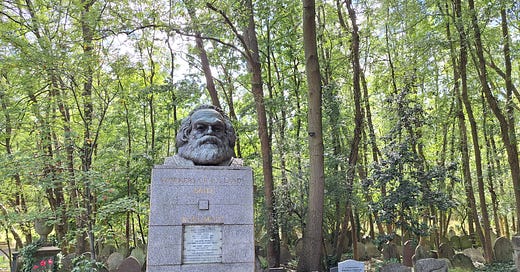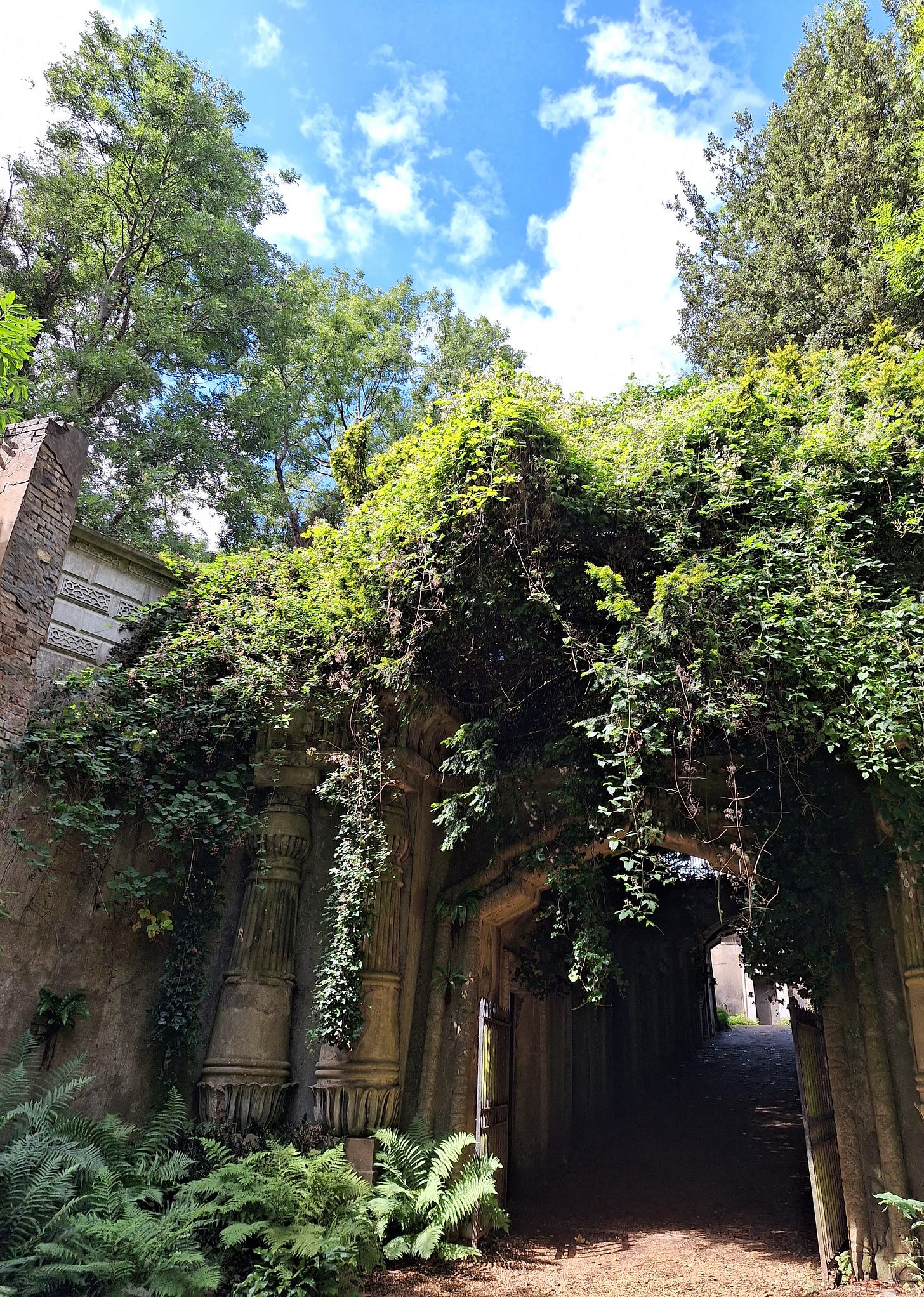Cemeteries are all the rage these days. To say we spend most of our lives conducting activities that delay our permanent arrival - exercising, eating vegetables, drinking water - we love a day out in the place where the dead far outnumber the living.
London has seven cemeteries that are worth a visit just to have a look around. Together they’re known as the magnificent seven, but the best of them all, the cemetery that looks down on all the other cemeteries, is Highgate.
Highgate’s clearly the best and because of this it’s not cheap. Unless a friend or relative is spending their eternity here, it’s ten pounds, please. Want to join the tour so you can go into the catacombs and really get your money’s worth? That’s another five. No one I know, or knew, I suppose, is in Highgate, so I hand over the money and tag along on a tour that’s just starting.
It’s run by a friendly American, a volunteer, as pretty much all those who work at the cemetery are, and most of my fellow tourists are old enough to look like they’re on a scouting mission, on the lookout for their final resting place.
The tour is only of the western section of the cemetery. Much like London, it’s the fancy, expensive bit. The eastern end can be visited for only four pounds and you don’t need a guide to be able to find what everyone is looking for: Marx.
Karl Marx was buried here when he died in 1863, first in a standard, modest grave, and then a year late reinterred into a tomb that is topped, crowned really, with a giant bust of his head.
“He’s a real money-maker for us,” says our guide. If Karl could still spit feathers, they’d be all over the cemetery at this remark. His tomb is the reason most people visit. When I’m leaving the eastern section I hear an American family attempting to buy tickets, “we’re really interested in seeing Karl Marx, but we’ll happily look around the rest.”
The fact that Highgate charges admission is, unsurprisingly, quite controversial. But back in the older, western section it’s clear they need the money. It’s a grand old place, but lots of the graves are damaged. Bits have fallen off, eroded away. The odd tomb has just broken apart entirely, its remains taken out and hidden away.
It looks like a forest, which is accidental and inconvenient. Our guide says that most of the trees are, like him, volunteers. They’ve cropped up all on their own and are now wreaking havoc with the graves. Rest in peace? That’s pretty hard to do when you’ve got a sycamore tree making a mess of your pelvis.
They still sell plots, though. If an eternity in the company of the likes of Marx, George Michael, Christina Rosetti, sounds like your sort of thing, then you’re in luck. Although, no, sorry, you can’t buy an eternity anymore, there simply isn’t the room. A plot is available for 75 years, and that’s your lot. Even the afterlife has a housing crisis. Once your term is up you better hope you’ve bred some very considerate ancestors, otherwise you’ll be on the move again.
Our tour trundles up the hill, through some of the more spectacular parts. There’s the Egyptian Avenue, a steep hill boarded on both sides by mausoleums, their designs a nod to the pharaohs. There’s the Circle of Lebanon, an impressive ring of permanent homes for some of London’s richer dead.
Then there are the catacombs. You can only visit these on a tour, though if you’re short a fiver you’re not missing much. Our guide opens the padlocked door and we go into a dark, damp corridor that smells like a basement with dodgy plumbing.
If you like getting really up close and personal with the afterlife, this is the place to be. The dead here are almost literally climbing out of the walls to say hello. The coffins are right on show, sitting there in front of you.
“It’s odd that you can just see the coffins right there,” says a German who could, if he wanted to, make understatements a lucrative line of work.
“And they’re all so intact,” says a lady from San Francisco, which makes me think that she and I must have quite different definitions of the word ‘intact’. Some of the coffins are breaking apart at the edges, the lead lining visible beneath the wood. It’s all a bit much for an Italian lady who promptly turns and leaves.
The rest of us follow shortly afterwards and the tour proceeds downhill. We take in more famous graves. The scientist Michael Faraday and his wife are buried right up beside the wall. Alexander Litvinenko is here, so’s Lucian Freud.
The list of Highgate’s most famous tenants is a Guardian crossword-setter’s dream. It’s full of bloke-from-that-thing’s, woman-that-wrote-that-thing-you-like’s. Highgate gets all the people that didn’t quite make Westminster Abbey, the second tier, as our guide puts it. Charles Dickens may not be buried here, but the rest of his family are.
But then there’s Karl Marx. I leave him until last. Even if you manage to miss the enormous carved head, he’s easy to spot. His is the only grave with a crowd. As I stand and contemplate…what, exactly? Capitalism’s victory over communism? The plight of the worker? The size of the stone that would be needed to carve out the substantial real estate that is my head? A woman comes up to me and asks me to take a picture of her and her family. She and the other woman smile, the man doesn’t. He looks stern, sad, in mourning. Cheer up, I want to say. I know this is a graveyard but we get to leave.
I decide it is in fact time to go. I walk on out of the eastern end via the toilets - very clean, the dead don’t make much mess - and think as I do that if I end up rich or with a lot of spare cash on my hands maybe I’ll buy a plot in Highgate Cemetery. There would be much, much worse places to spend eternity.
Or 75 years, at least.
Some housekeeping.
If you’d like to discover more newsletters like mine, you can subscribe to The Sample, which curates the best newsletters and sends you those worth subscribing to. You can subscribe through this link. Doing so helps this blog get more readers so please do check it out.









What an enjoyable read! Your writing is smart and clever without being a bit pretentious, i.e. my favorite kind.
It feels like a very Western idea to visit cemeteries of famous people. Especially to pay!
On a separate note, great read! I’d love to hear what you have to say about travelling here in Japan. If you ever think about it, I’d love to talk and maybe we can collab